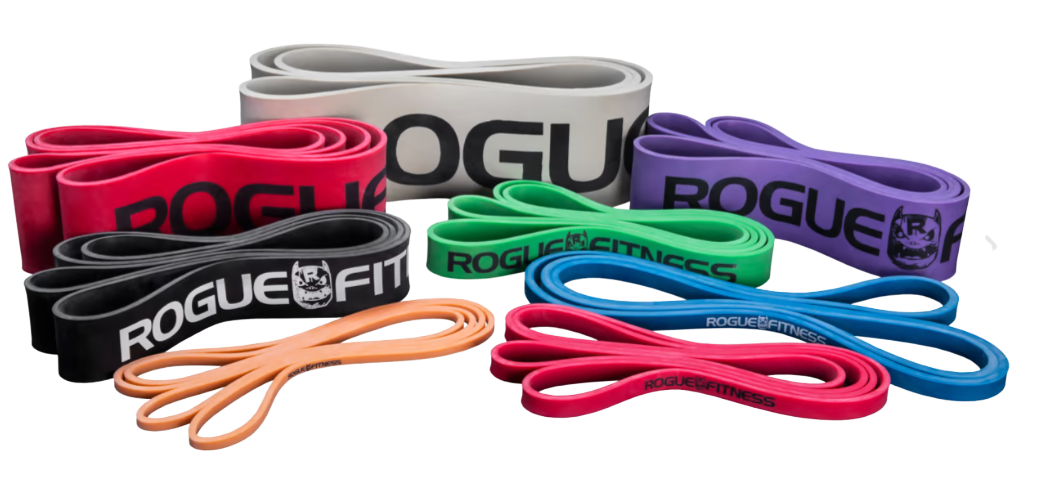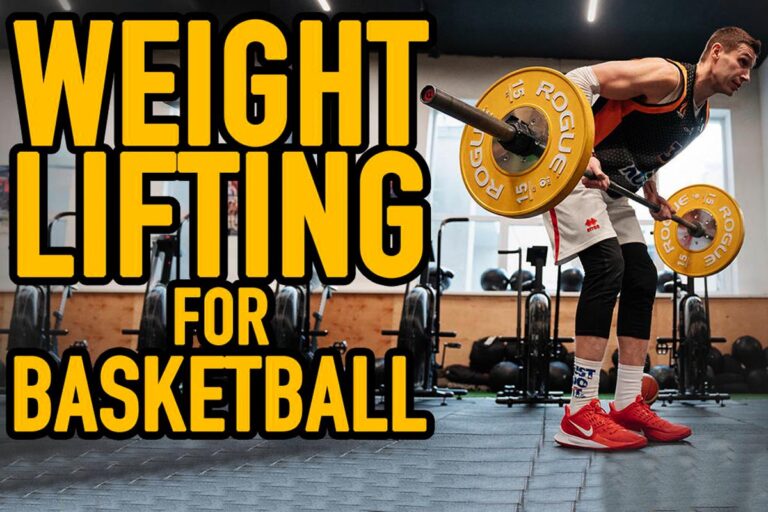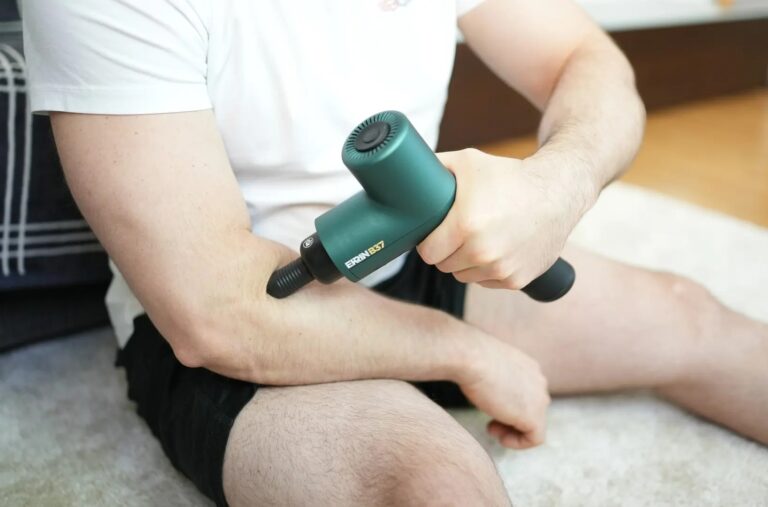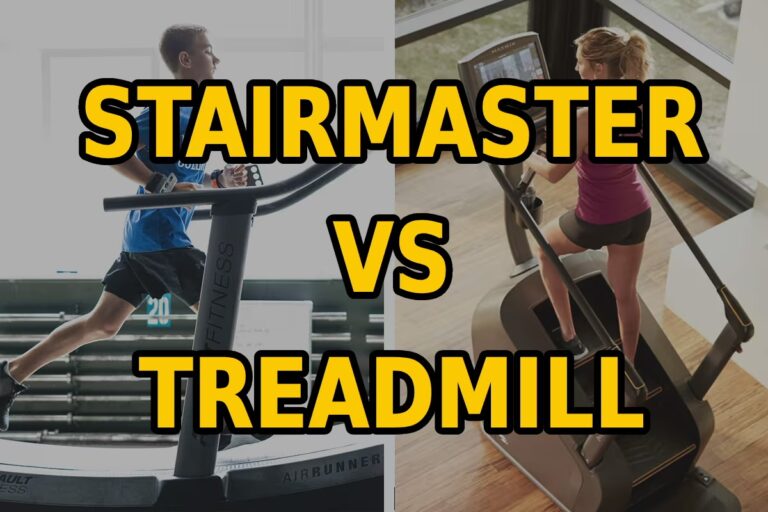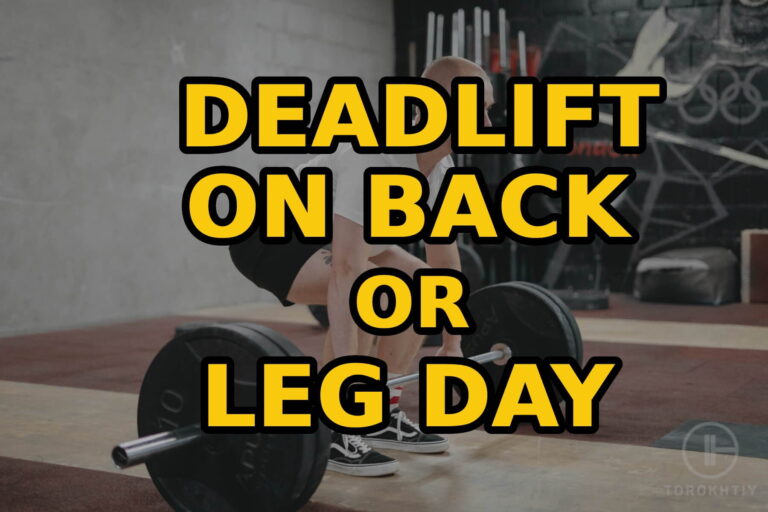Bicep Exercises with Resistance Bands: In-Depth Look
The bicep exercises with resistance bands will work the long and short head of the biceps, while also stimulating the brachialis muscle. These exercises along with your general compound exercises and free-weight isolated movements will give you the complete physique that you desire.
The best bicep exercises with resistance bands include a straight arm curl, a single arm curl that stretches the bicep muscle in the bottom position, and a hammer curl variation. These three will give you a thorough bicep workout, but there are several other exercises to enhance your workout variety.

Band Biceps Workout Benefits
✅More Tension in Your Biceps
One of the best benefits of using bands for your bicep workout is having a higher degree of tension in your bicep muscle. With dumbbells, you can lose tension in the peak contraction of the muscle or lose the tension at the bottom position when your arms are by your side. But with bicep curls with resistance bands, the tension is the greatest at the contraction phase because the band is the most stretched. Even during the eccentric phase, you have to resist the band and when your arms are by your side, the band is still pulling down, so you have more biceps engagement.
You can further increase the tension on your biceps by starting your workout with the band already stretched. This way, even in a rested position, you will feel your biceps are engaged. This also helps with the mind-muscle connection that has been proven to aid muscle growth.
✅ More Versatile Bicep Workout
Resistance bands are versatile pieces of workout equipment. You can do your typical variation of dumbbell or barbell curls with the resistance band. In addition, you can tie the bands on a stable post and do different cable curl variations as well. Lastly, bands work great for unilateral work as well and there is a higher degree of difficulty and tension when trying to curl with just one arm.
Also, you can perform workout techniques like drop sets seamlessly by changing the width of your stance. Once you reach your failure point during your curls, you can simply narrow your stance, get extra reps in and narrow it further to go to complete failure.
Not to mention the fact that resistance bands are great for your entire body and especially for warming up different muscle groups and joints. So, a single resistance band is likely to provide you with more bang for your buck than a single kettlebell or dumbbell.
✅ Less Stress On Your Joint
A drawback to the traditional barbell and dumbbell bicep routine is that it can lead to discomfort in your elbow because you’re constantly using that joint. The repetitive motion can cause inflammation in your elbows, but when you perform bicep curls with bands instead, your joints have less stress. This is because the band tension is more equally distributed throughout the movement than the weight distribution of a dumbbell or barbell curl. So, there is no point in the banded movement where there is more stress on your elbow joint.
This reasoning also works with wrist pain. Some people can have wrist pain from curling dumbbells and especially barbells because it’s harder to have a natural path of motion with a barbell. But, resistance bands allow for more flexibility, putting less pressure on your wrists and making them safer.
✅ Budget Friendly
To get a proper bicep workout, you would either need dumbbells, machines, or resistance bands. Machines can be very expensive, plus take up a lot of space. While dumbbells are a good option, you would need a wide range of them in order to have a proper arm workout. This can result in you going over your preferred budget. That’s why resistance bands are so sought after. They are both budget-friendly and have a wide resistance range to stimulate muscle growth. Just 2 or 3 bands can be enough to get a complete workout.
✅ Can Travel with Your Resistance Bands
Consistency is one of the most important attributes when it comes to gaining muscles and strength. But if you’re someone who has to travel a lot or might have trouble going to the gym, resistance bands are a great option. They are easy to travel with and don’t take up much space. They can easily be stored in your bag or you can purchase a special carrying bag for your bands. So, you can get a good arm workout anywhere you go.
This doesn’t hold true for other equipment like dumbbells or kettlebells, which are much harder to carry around.

Top Bicep Workouts with Resistance Bands
The bicep muscle has 2 main parts. The short head of the bicep is located on the inside of the arm and the long head is on the outside. There is also a smaller muscle located underneath called the brachialis. In order to get a full bicep workout, it’s important to hit all 3 parts with your resistance band bicep workout.
Additionally, it’s safer to perform burnout sets with resistance bands as you’re not overworking the wrists or elbows. These burnout sets can be great to take your biceps to failure and produce muscle growth.
1. Straight Arm Curls
Starting off your bicep band workout, you want to first target the short head of the muscle. You can use a straight-arm resistance band curl. This can be performed with one hand or two.
- Stand shoulder width apart with the band looped under your feet. Your stance can control the difficulty of the exercise. The narrower your stance, the less tension and easier the exercise will be and vice versa. The wider your stance the more resistance you will feel.
- Grip the band with your palms facing up. Make sure you have a tight grip and that your wrists are in a neutral position.
- Curl your arms up from your sides. You should almost touch your forearm to your bicep. That’s when you’ll feel peak contraction of the bicep muscle.
- Bring the band down in a controlled manner. The eccentric is important, so don’t let your arms drop down.
- Ideally, you would want to do 3 to 4 sets of 8 to 12 reps. And don’t forget a nice, controlled tempo the entire time.
2. Single Arm Curls
In order to target the long head of the muscle, you want to make sure you get a deep stretch of your biceps.
- Loop your band around a stable post and grip the other end with one hand.
- Face away from the post and take a few steps, so you feel the tension in the band already and your arm is slightly behind your torso. You should already feel a stretch on your biceps.
- Keeping the palm up once again, curl the band until your arm is above parallel and you feel your bicep contracting. You can hold this position for a one count if you like.
- Lower your arm back, but do so in a controlled manner. It’s good to do it for a 3-second count. Make sure you’re getting a deep stretch before curling up again.
- Switch arms once you’re finished with one hand.
- Once again, 3 to 4 sets of 8-12 reps will be ideal for this type of workout.
3. Hammer Curls
For the brachialis muscle, a variation of a hammer curl with a neutral grip works best. This workout will also provide you with some forearm stimulation while working on that peak head of the bicep.
- Take a shoulder-width stance and remember that the width of your stance determines the resistance and tension of the band.
- Instead of gripping the band from the inside, hold the band from the outside, so you have a neutral grip. A neutral grip means that the knuckles of your hands are facing each other.
- Curl the band up until you feel a peak contraction.
- Lower the band in a controlled manner. Once more, a 3-second count works great for this.
- For this, 2 to 3 sets of 8 to 12 reps can be plenty.
4. Reverse Band Curls
An additional biceps exercise you can perform is the reverse band curls, which will also stimulate your forearms. This is especially great for those who have some elbow pain or discomfort as strengthening your forearms helps deal with elbow pain.
- Similar to the straight arm curls, stand shoulder-width apart with the band looped under your feet. Keeping in mind the correlation between stance width and band tension.
- Grip the band with your palms facing down this time.
- Curl your arms up from your sides. You should feel your forearms working. Curl until you feel a contraction of the biceps muscle.
- It’s important to lower the band in a controlled manner, so your forearm carries the tension load.
- You would want to do 2 to 3 sets of 8 to 12 reps.
5. Close Grip Curls
For the last banded bicep workout, there are the close grip curls which really work the peak contraction of the bicep muscle. These can be added to the end of your bicep workout as a burnout set.
- Stand shoulder-width apart with the band looped under your feet. Because the aim is to get higher repetitions, you could take a narrower stance.
- Grip the band so that your hands are resting on your legs rather than beside them.
- Curl upward. If your elbows flair out a little bit it’s fine. As long as you get peak contraction of the bicep muscle.
- Lower the weight down slowly, so the bicep is constantly working during the entire movement.
- You can either do a normal set and rep scheme of 2 to 3 sets of 10 to 20 reps. Or, you can perform this as a burnout set of 1 or 2 sets of 20 to 30 reps.
How to Pick Resistance Bands for Biceps Workouts?
1. Tension
Your biceps, like most other muscles in your body, perform really well when they receive various different stimulations. So, having different tension bands is key. Typically, resistance bands come color coded with each color correlating to a specific poundage or a range of pounds.
So, it’s best that you have a few different band options, so you can perform rep ranges anywhere from 6 reps to as high as 30. This will include a band that is as light as 10 pounds and one that maybe be as heavy as 50. This will help make consistent progress with your biceps gains.
2. Length
Most bands are 41 inches in length. However, this might be too long or too short depending on your height. But, as mentioned above, the length of the band doesn’t have to be a limiting factor. If the band is too short, you can simply narrow your stance and if it is too long, you can widen your stance. Playing around with your stance will help you find the perfect positioning that allows you to get a killer biceps workout.
3. Width
The width of the band is very important. Width is what determines the lightness or heaviness of the band. Lighter bands have a smaller width and heavier ones have a wider width. Again, you can increase the tension of the band further by widening your stance or stretching the band prior to the actual lift.
It’s best that you get a couple of different bands with different widths as it will allow for more versatility.
4. Material
Resistance bands are made of many materials, the two most common being latex and rubber. Latex is thought of as more durable and long-lasting. Latex also has snap resistance, which helps with the tension of the band.
Resistance bands made of rubber tend to be less expensive, however, the rubber material is thought of as sticky and can be an irritant to one’s skin or hair.
5. Additional Perks
A small issue with bands can be that once you’ve used them for a long time, it can be difficult to get them to stay in a neat, rolled-up manner. Certain companies provide you with band ties, so once the band is rolled up, you can place the ties over them and the band will stay in place.
While with others, you can purchase a set of bands that comes with a small carrying bag. This way you have a specific place for your bands. You can even throw this carrying bag into your larger gym back or simply carry it around with you.
The Resistance Bands We Recommend
A resistance band that covers all of these factors and is likely to provide you with a great biceps workout among other workouts is the Rogue’s Echo Resistance Bands. These bands come with the ideal 41 inches length with a width that ranges from 0.25 inches to 4 inches. The width increases with the resistance level of the bands. The bands have 8 coloured coded resistance levels with the lightest one being orange which has 15 pounds of resistance and the heaviest being silver with 200 pounds. Now, for your biceps workout, you’re probably not going to need 200 pounds. Instead, a good target range can be the orange bands to the green ones. This covers a range of 15 pounds to 65 pounds.
The bands are also made of durable latex rubber, so you don’t have to worry about them ripping or breaking apart quickly.
FAQ
How Many Bicep Curls Should I Do with Resistance Bands?
When it comes to building muscles, variety can be the key. So, ideally, you would want to cover a range from 6 reps to 30 reps. This can be broken down to doing one workout that is between the 6 to 8 rep range. Another that covers 8 to 12, and a burnout type set that ranges between 15 to 30 reps.
These different sets and reps ranges will provide you with enough variation and stimulation for muscle growth.
Are Resistance Bands Good for Bicep Curls?
Resistance bands are a great option for bicep curls. They put less stress on your elbow joint while keeping constant tension in your bicep throughout the range of motion. Additionally, resistance bands are easily portable, so you can keep consistent with your workout.
Also, they are relatively inexpensive compared to dumbbells or barbells.
Yes, the hook grip can cause some pain, but with proper technique improvements, you can reduce most of the pain. After a few weeks of using the hook grip properly, you can get used to the minor level of discomfort left, while enjoying better pulls.

Conclusion
There are several bicep exercises with bands that you can perform in order to grow your biceps. The major benefit of using resistance bands is that they keep more tension on the biceps while keeping the stress of the workout away from your joints. However, in order to build a complete physique, resistance bands should be one of the tools along with compound movements, machines, and isolated movements with free weights.
What are your favorite bicep exercises to do with a resistance band? Do you have any personal tips to engage the biceps further during your workout? What’s the best benefit you feel when using resistance bands?
Let’s discuss all of this and any other questions you might have in the comment section below!
Also Read:
- Bench Press With Resistance Bands
- Best Pull Up Assist Bands
- Shoulder Band Stretches
- Resistance Band Squats
- Resistance Band Tricep Workout
- Resistance Band Chest Exercises
- Best Resistance Tubes
- Best Resistance Bands Reviews
- Best Kettlebells
References:
- How to Improve Your Grip Strength // Health Line:
https://www.healthline.com/health/grip-strength - 5 Ways To Grip Your Deadlift Like A Vise // Body Building: https://www.bodybuilding.com/content/5-ways-to-grip-your-deadlift-like-a-vise.html
Why Trust Us?
With over 20 years in Olympic Weightlifting, our team does its best to provide the audience with ultimate support and meet the needs and requirements of advanced athletes and professional lifters, as well as people who strive to open new opportunities and develop their physical capabilities with us.
By trusting the recommendations of our certified experts in coaching, nutrition, dietology, and sports training programming, as well as scientific consultants, and physiotherapists, we provide you with thorough, well-considered, and scientifically proven content. All the information given in the articles concerning workout programming, separate exercises, and athletic performance, in general, is based on verified data. We ensure that you can rely on our professionals’ pieces of advice and recommendations that can be treated as personalized ones which will benefit you and fully meet your needs.
The product testing process is described in more detail here
Author: Tanya Shaiko
News Editor, Olympic Lifting Enthusiast
Best Results: Snatch – 61 kg,
C&J – 78 kg
I’m Tanya, and I just can’t do without fitness. About six years ago, I got into Olympic weightlifting and instantly fell in love with it. Weightlifting is like no other sport – it’s just you versus the bar. Driven by my unwavering passion for an active lifestyle, I’ve been eager to share my personal journey and sports enthusiasm with others. As a journalist and photographer, my interests come full circle, adding an extra dimension to the news column that I curate. This way, I keep my readers updated with the latest happenings in the sports world.

